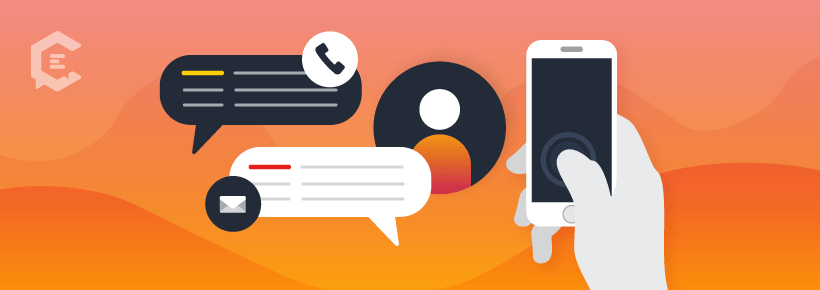The best way to build and maintain valuable, meaningful, and long-term customer relationships today is with content.
High-quality, effective content should solve or address customers’ biggest challenges or issues. It should be informative, helpful, and valuable.
So, yes, content is still effective today. However, the effectiveness of the content you provide to customers only goes so far. Delivery is the other aspect of effective content that can make all the difference.
How exactly do you go about this?
Marketing tech and tools for customer support teams:
If this seems like an impossible feat, don’t fret. We’ll show you how to use various marketing tech tools and solutions, including ClearVoice, for creating customer support content.
We will also show you how different marketing tech solutions can enable customer support teams to navigate that content for use in their own correspondence with customers via email, chat, and phone.
1. Leverage customer support software knowledge base functionality.
Whether it is looking for more information about your product and/or service, pricing, or how to do something, customers love being able to visit a website and find exactly what they are looking for. If that process is easy and provides them with a seamless, interactive, and engaging way for them to find answers for what they are looking for, then you’ve nailed the customer experience.
For the self-sufficient customers out there, an online knowledgebase can help put them in the driver’s seat. A knowledgebase essentially serves as an online hub that houses all resources related to your business’ services or software. These resources can include videos, how-to articles, service guides, FAQs, and more.
For example, HappyFox is one example of a web-based tool that allows you to build an online knowledge base that is attractive, easily searchable, mobile responsive, and everything your customers need to find what they are looking for quickly.
2. Make customer onboarding activities enjoyable and engaging.
If a lead or contact becomes a customer, they are likely eager to get up and running right away. However, depending on your product or service, it can be difficult to get customers to complete 100 percent of their onboarding activities.
For example, Uberflip designed a fun, enjoyable, and engaging way to get customers to complete their onboarding process. Uberlfip offers customers opportunities to earn points through their “Challenges” activities.
These activities include the following:
- Watching a series of videos, which detail the onboarding process as well as introduce the onboarding team
- Setting up integrations with third-party tools, such as HubSpot
- Sharing photos of customers using certain features
- Participating in polls and quizzes to show customers’ levels of understanding of key features and functionalities
- Providing feedback on their overall experience
Now think about your own onboarding process. How can you spice it up a bit to make it more fun, engaging, interactive with your existing content and marketing tech stack? Have a brainstorming session with your sales, marketing, and customer support teams to come up with ideas on how to jazz up your onboarding process to ensure customers are successful — from start to finish.
Not only will a fun onboarding process enable more customers to complete their onboarding activities, but it will also improve the overall customer experience.
3. Use a chatbot to vet incoming customer service requests.
More and more businesses today are designing and building chatbots to help them perform a number of basic tasks, including fielding customer service requests.
These chatbots are designed with artificial intelligence (AI) features that allow them to interpret and understand customers’ requests. Chatbots with AI features are also designed with natural language processing (NLP), which allows them to interpret a customer’s needs based on certain words. Then, the chatbot processes those words and provides customers with introductory content as well as content relevant to their needs and challenges.
After this step, a human customer service representative steps in and works with the customer to provide them with the personalized support they are looking for.
In this example, customers receive the best of both worlds: an immediate response and content and resources that answer their questions or address their challenges, and personalized support and service by speaking with a human being about their specific challenges and needs.
You can leverage technology and content to improve the customer experience without sacrificing the personalization factor.
4. Build a support editorial calendar.
No, this isn’t the same editorial calendar you would use for scheduling and managing content marketing activities and initiatives. A support editorial calendar helps teams to manage customer support ticket assignments, so no customer request gets left behind. This allows team members to see which tickets are assigned to whom, details related to each request, and when each is due.
Sit down with your customer support management team to build a support editorial calendar. Not sure how to build one or need help? The good news is there are a ton of great martech tools out there to help you build and manage your calendar. ClearVoice offers a great support editorial calendar to help get you started.
With a support editorial calendar available for all to access, you remove a lot of the guesswork among team members as to who is working on what request or ticket as well as reduce the risk of letting requests fall through the cracks.
5. Connect social personas to customer accounts — digitally.
If your business offers a software (SaaS) product or any type of online account for customers, then consider adding a social login option to help streamline the account setup and management process for customers.
For example, you can build the option for customers to “Log in with Google” or “Log in with Facebook.” Not only does this make the account accessibility process easier for your customers and users, but it also provides you with the ability to link their social accounts to customer records.
Customers also enjoy the convenience of this feature since it doesn’t require setting up a new account or log in. By simply logging into their social accounts, they can also log into your SaaS product, tool, or system.
If you already offer a social login feature but few customers are actually using it, here’s your chance to learn more about why. You can send out a survey or ask customers for feedback directly. You can also offer an incentive, such as a discount, rewards points, or another type of offer or bonus to customers who use it more.
Give customer relationships that added “spark” by igniting them with interactive content.
Finally, never underestimate the power of content. Even though content marketing has evolved far beyond the written word and is more about shaping experiences, this simply means businesses and customer support teams should be focusing on providing content to customers when they need it.
By arming your customer support team with content via various martech tools and solutions, you can not only provide customers with the right content at the right time, but you can also spark long-term, meaningful customer relationships.






